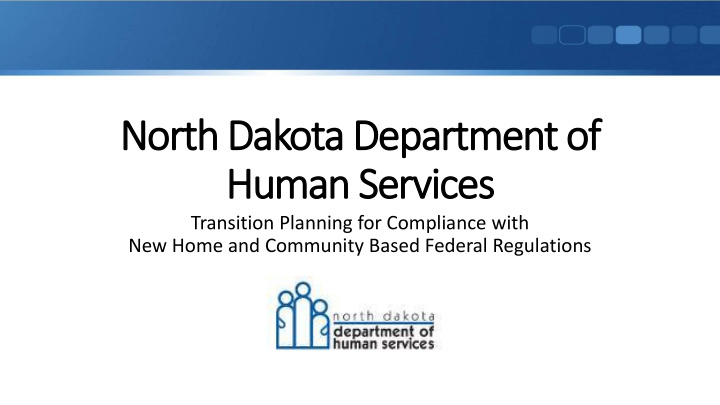



North Dakota Department of Human Services Transition Planning for Compliance with New Home and Community Based Federal Regulations
Overview of the Federal Regulations A final rule (CMS 2249F) was issued in January 2014 that affects home and community- based services (HCBS) provided through Medicaid waivers. The new regulations: 1. Provide a new definition of a home and community-based setting 2. Define person-centered planning requirements and conflict of interest standards for case management 3. Require states to develop transition plans for bringing all HCBS settings into compliance The objective is to ensure that HCBS waiver participants can enjoy the benefits of living, working, and participating in their communities.
ND Transition Planning • DHS must submit a “statewide transition plan” to CMS that addresses how it will comply with the HCBS settings requirements for all 6 Medicaid 1915(c) waivers : 1. Aged and Disabled HCBS Waiver 2. Autism Spectrum Disorder (ASD) Waiver 3. Children’s Hospice Waiver 4. Medically Fragile Waiver 5. Technology Dependent Waiver 6. Traditional IID/DD HCBS Waiver • The 30 day public comment period begins October 15, 2014 • Plan is due to CMS in November 2014
HCBS Settings Requirements Overview All Medicaid HCBS settings must: • Be integrated in the community and provide full access to the greater community • Be selected by the individual from among multiple setting options • Support the individual’s choice of services and supports • Ensure privacy, dignity, respect, and freedom from coercion and restraint The rules applies to both residential and day settings • Guidance for residential settings available on CMS’s website • CMS plans to issue additional guidance about day settings in the future
HCBS Settings Requirements Overview Individuals in all HCBS residential settings should be able to have: • Freedom to control their own schedules • Privacy in their living unit • Freedom to furnish or decorate their unit as they wish • Choice of roommates • Access to food at any time • Visitors at any time If any right is not met for health or safety reasons must be explained and documented in the individual’s person -centered service plan
HCBS Settings Requirements Overview Requirements for provider owned or controlled residential settings: • Certain requirements further scrutinized • Legally enforceable agreement or lease must be in place • Same responsibilities/protections from eviction as all tenants under landlord tenant law • Modifications are documented and justified in the individual’s person - centered service plan
HCBS Settings Requirements Overview Settings CMS considers NOT Home and Community-Based: • Nursing Facility • Institution for mental diseases • Intermediate care facility for individuals with intellectual disabilities (ICF/IID) • Hospital
HCBS Settings Requirements Overview Settings CMS considers PRESUMED NOT to be Home and Community Based: • Are located in/on the grounds of/adjacent to a public institution • Are in a publicly or privately-owned facility providing inpatient treatment • Have the effect of isolating individuals from the broader community, such as: o Farmsteads in rural areas o Gated communities for people with disabilities o Residential schools o Multiple settings States submit evidence demonstrating settings have qualities of home and community- based settings and go though CMS heightened scrutiny
Person-Centered Planning Overview The person-centered planning process must: • Allow the individual to lead the process, when possible • Include family members, friends, and others selected by the individual • Provide individuals with necessary information to make informed decisions about their choice of available services and providers • Reflect the individual’s strengths, preferences, goals and desired outcomes
How to Submit Public Comment Comments and public input on this preliminary transition plan can be submitted to North Dakota Department of Human Services during the comment period of October 15, 2014 – November 14, 2014 in the following ways: Email: DHSHCBS@ND.GOV Phone 800-755-2604 or 701-328-4602 Fax 701-328-4875 Mail: ND DHS Medical Services Division 600 E Blvd Department 325, Bismarck, ND 58505-0250
Final Rule Medicaid HCBS CMS HCBS Regulations was an overview. For the full rules and more information please visit: http://www.medicaid.gov/Medicaid-CHIP-Program-Information/By- Topics/Long-Term-Services-and-Supports/Home-and-Community- Based-Services/Home-and-Community-Based-Services.html
ND State Waiver Transition Planning Questions?
Recommend
More recommend